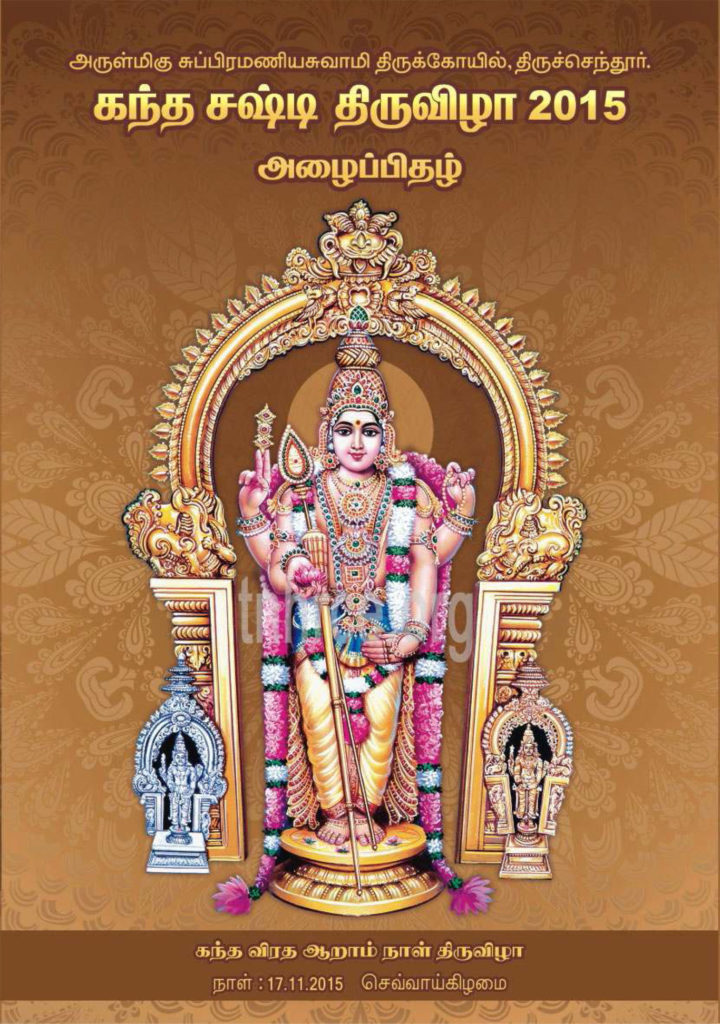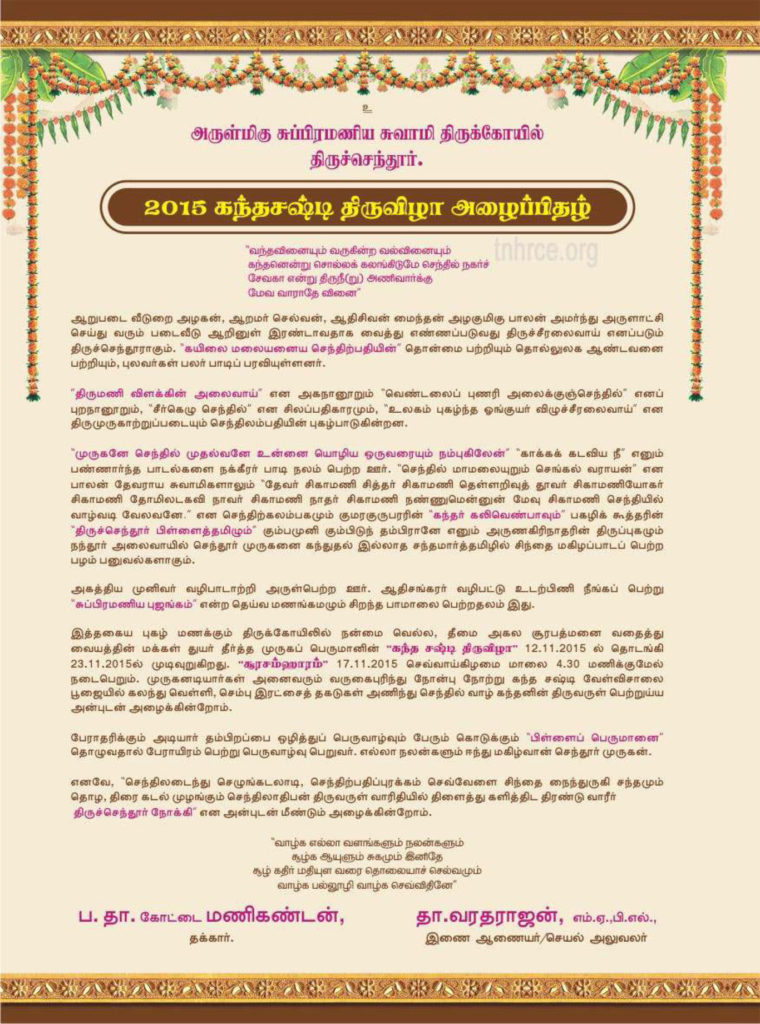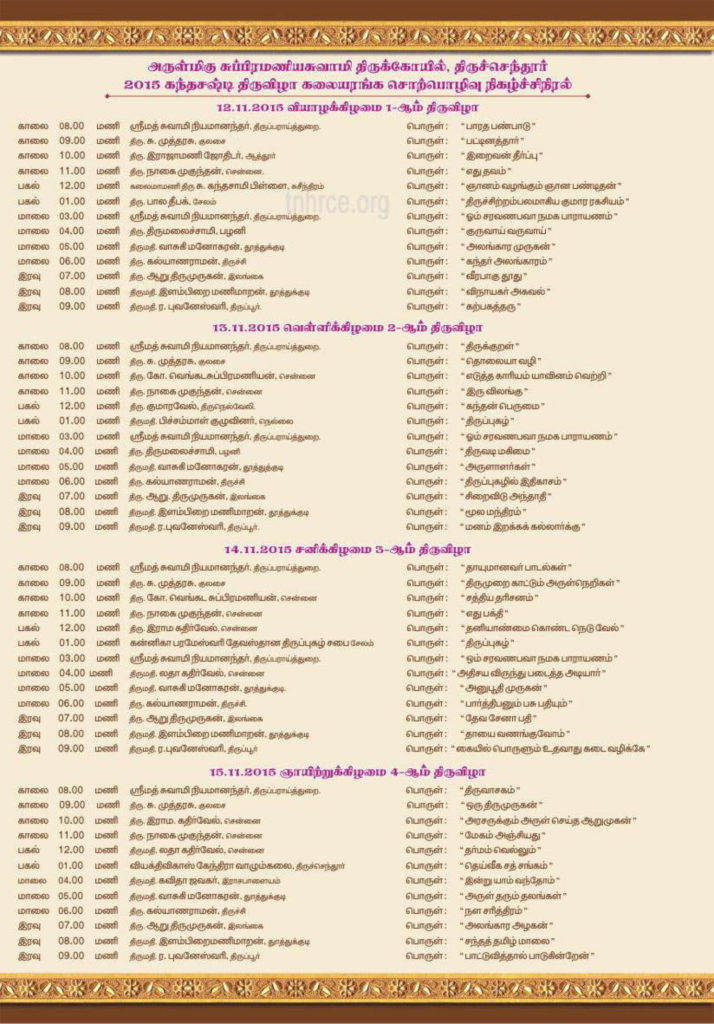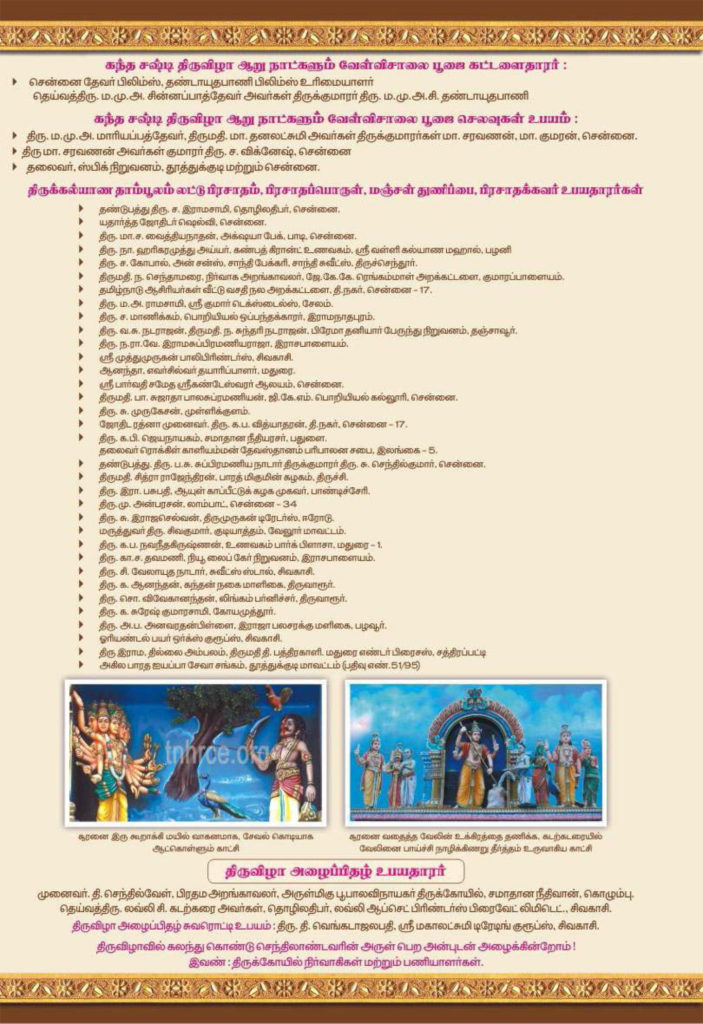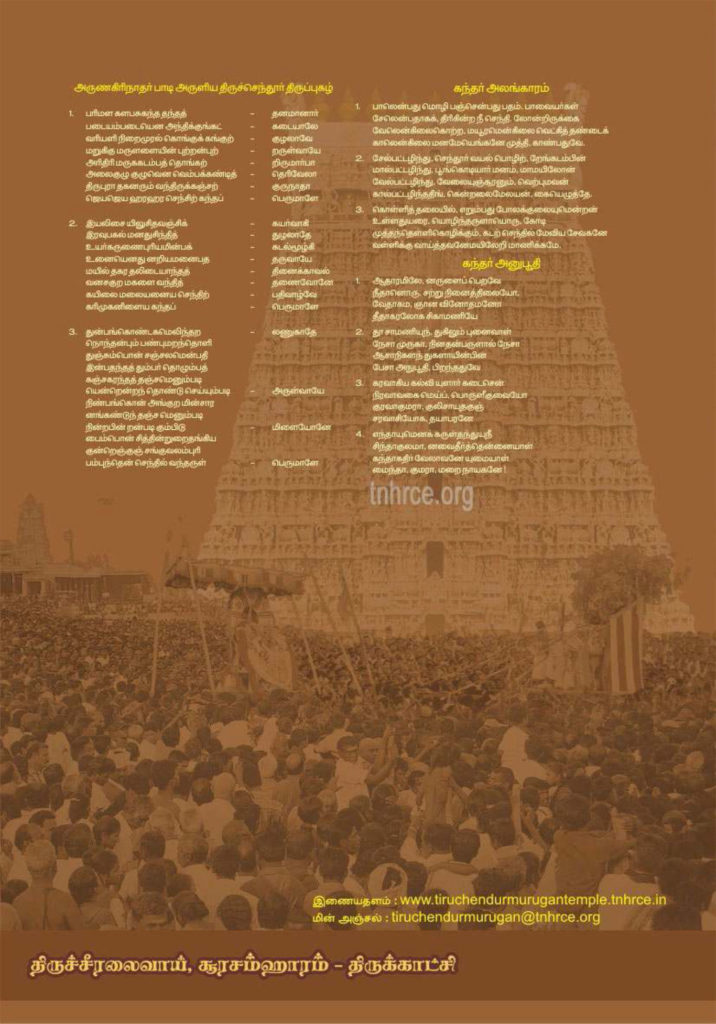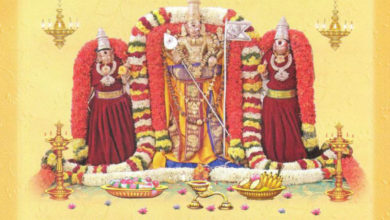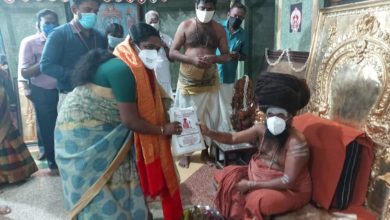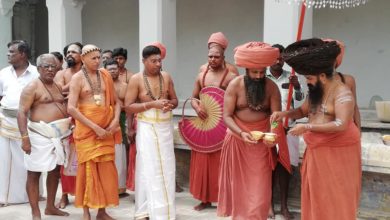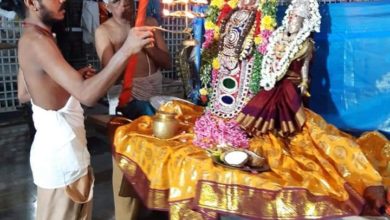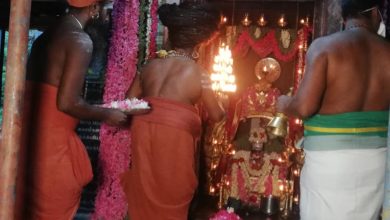
Tiruchendur Arulmigu Subramaniya Swamy Temple Shasti Festival Invitation 2015
Tiruchendur Arulmigu Subramaniya Swamy Temple Shasti Festival Invitation 2015
Moolavar: Subrahmanya Swami
Urchavar: Shanmukar, Jeyanthinaathar, Kumaara Vitankar, Alaivaay Perumaal
Amman / Thayar: Valli; Deivaanai
Old year: 1000-2000 years old
Festival:
Pankuni Uthiram, Tirukkaarthikai, Vaikaasi Visaakam, Kanda Sashti. In the Murugan temples, the Kanda Sashti festival is celebrated for six days only. In some temples it is celebrated for seven days, with the divine wedding of Lord Muruga the next day to Sashti. But, in Tiruchendur the festival is held for twelve days — the first six days of Kanda Sashti comprise Sashti Vrattam (the vow of Sashti) and Soora Samharam (the annihilation of the demon, Soora), on the seventh day it is the divine wedding of Lord Muruga and Deivaanai, and in the next five days, the Lord in His wedding gear appears and blesses in the ‘Unjal Sevai’ that is, sitting on the Swing.
Temple’s Speciality:
Of the Aaarupatai Veetu of Lord Muruga, Tiruchendur alone is situated in the seashore; the other five are hill temples
Opening Time:
The temple is open from morning 5 o’ clock till 9.00 pm.
Address:
Arulmigu Subrahmanya Swami Tirukkoil, Tiruchendur, Tuticorin District.
Phone:
+91-4639 – 242 221
General Information:
The offerings to Lord Muruga : At Tiruchendur, every day 9 times poojas are performed for Lord Muruga. During these poojas different naivedyams (food offerings) like dhal pongal, kanji (gruel), thosai, appam, ghee-rice, balls made of cooked greengram and jaggery are offered. Though there are many temples for Lord Muruga in Tamilnadu, six temples are specially worshipped as ‘patai veetu’ (armory house). Where the Commander-in-chief who goes for battle stays with his army is called ‘patai veetu’. Accordingly, Tiruchendur is the only place where Lord Muruga with His army stayed, when He went to raze down Soorapadman. But, we call ‘Aarupatai veetu’ the other five temples along with Tiruchendur. To a poverty-stricken man, a person who has won poverty will point to the patron’s place and pacify the man saying that his poverty will be annulled if he goes there.
Prayers
Those who face impediments for their marriage, pray to this Lord; they are blessed with good wedlock.
Thanks giving:
We can conduct abishekam to the Lord and His Spouse and offer new clothes.
Greatness Of Temple:
Lord Muruga won and accepted Soorapadman on Sashti (sixth day) of the waxing moon (bright) night (valar pirai) of the month Aippasi. This day is celebrated as ‘Kanda Sashti’. This incident happened at Tiruchendur and hence, the ‘Kanda Sashti’ festival is calebrated in this place with all grandeur. In the ‘Kanda Purana’ of Mahabharatha, two other causes are indicated for the celebration of ‘Kanda Sashti’ festival, apart from the extermination of Soorapadman. Once a few sages conducted a yaaga (sacred fire worship) with a behest to get a son for the welfare of the world. It was begun on the New Moon Day and went on for six days. From the fire erupted out of the sacrificial altar (yaaga kundam), six seeds – one seed each day for six days respectively – were collected. Lord Muruga was born on the sixth day, when all these six seeds were made as one. The Mahabharatha asserts that the day of the birth of Lord Muruga is the ‘Kanda Sashti’ Day. In the Kanda Purana, Kachiappa Sivaachaariyar says that the Devas, in order to become powerful to challenge the asuras, carried on a vow by soliciting Lord Muruga to be in the ‘kumbham’ (sacred pot) for six days. Lord Muruga blessed them likewise. This incident is remembered as ‘Kanda Sashti’ and celebrated after Aippasi New Moon Day – so says Sivaachaariyar.
Temple History:
Sashti Yaagam : At Tiruchendur, on the first day of the ‘Kanda Sashti’ festival during early morning, comes Jeyanthinaathar (Lord Muruga) with His spouses Valli and Deivaanai, representing the Prime Deity. The yaaga commences in the hexagon shaped sacrificial fire altar (yaaga kundam) for the victory of Lord Muruga. Around the altar, Lord Siva, Goddess Sakthi, the four Vedas, Lord Muruga, Valli, Deivaanai, Mahavishnu, Vinayaka, the seven Gurus, Vaastu Brahma, the Devas, the Sun, the Ashtadik Balakas (the guards of the eight sides), the Dwara Balakas (the Entrance Securuties) – all these devathas are made to rest in the kumbhams. The yaaga is conducted till noon and after the pooja Jeyanthinaathar goes to the Shanmugavilaasa Mandapam. On the sixth day, the Lord without His spouses, comes to the seashore and kills Sooran. After this, the Victorious Lord with Valli and Deivaanai returns to the yaaga saalai.
Abishekam to the Mirror : Jeyanthinaathar then comes to the sanctum of Mahaadevar at the paved corridor. At that time, a mirror will be placed before Him. The priest will conduct the abhishekam to the image of Jeyanthinaathar reflected in the mirror. This is called ‘chaayabhishekam’. ‘Chaaya’ means ‘shadow’. This abhishekam is performed to cool down the victorious Lord Muruga. The tradition is that Lord Muruga Himself enjoys seeing this Mirror Abhishekam. The Lord returns to His sanctum and with this, the event of Soorasamharam (the annihilation of Soora) comes to an end. On the next day that is on the seventh day, the holy wedding of Lord Muruga and Deivaanai is performed. Lord Indra not only gives in marriage Deivaanai to Lord Muruga for having defeated the asura but also renders service by becoming the holy peacock. This marriage happens at Tirupparankundram, the first ‘patai veetu’. At Tiruchendur, the holy wedding between Lord Muruga and Deivaanai is performed on the next day to ‘Kanda Sashti’ since it is the place where Soorapadman is vanquished. During the morning of that day, Deivaanai would go to the ‘tapasu mandapam’ and will do her tapasya to get married to Lord Muruga. In the evening Kumaara Vitankar ( another Utsava murthi), representing Lord Muruga goes to the tapasu mandapam seated on His peacock vehicle, garlands Deivaanai and gets engaged. During the midnight, both reach the ‘Tirukalyaana Mandapam’. There the wedding is performed. The next day, the Lord with Deivaanai goes on street procession. The next three days the Lord in the ‘Tirukalyaana Mandapam’ will be on the ‘oonjal’ (swing) and bless the devotees.
Turmeric Bath (‘manjal neeraatu) for Lord Muruga : During the festivals in the villages, the maidens enjoy by pouring turmeric water on the young boys on whom they have a customary claim for marriage. In a similar way, in this place also the ‘Turmeric Bath’ is conducted to Lord Muruga. On the last day of the ‘Kanda Sashti’ festival, Lord Muruga with His spouse Deivaanai goes in street procession. At that time, the devotees receive the Lord who has had His wedding in their village and to contain the rage happened due to the battle with Sooran, joyfully pour turmeric water on the Lord.
The Triple Lord Muruga : Lord Muruga is an incarnation of Lord Siva. He as a Guru to His father taught the meaning of the ‘pranava mantra’ OM. He imprisoned Lord Brahma since Brahma did not know the meaning of the same mantra. After extinguishing Sooran, He was the one to marry Lord Vishnu’s daughter. He was bound to the affection of His uncle, Lord Vishnu. Thus, Lord Muruga is related to all the three Lords, Trimurthis. To indicate this, Lord Muruga at Tiruchendur appears as an incarnation of Trimurthis, Lord Siva, Lord Vishnu and Lord Brahma during the festivals conducted in the months of Aavani and Maasi. On the 7th day evening of the festival, He is adorned with red dress and appears as Lord Siva. At the dawn of the 8th day, He is dressed in white and graces us in the form of Lord Brahma and during the noon He appears in green dress signifying Lord Vishnu. At Tiruchendur, the Rajagopuram is on the western side of Lord Muruga’s sanctum. Here, Lord Muruga faces east looking at the sea. The Rajagopuram should be opposite to the Lord in the east; since the sea is there in the east, the Rajagopuram is erected in the west. As the threshold of this gopuram is higher than the rostrum (peetam) of the prime sanctum of Lord Muruga, it remains always shut. During the ‘Kanda Sashti’ festival in the midnight of the Divine Wedding day, this door will be opened. At that time, however, the devotees will not be allowed to enter through that door.
Four Utsava Murthis : Generally, there will be only one Utsava Murthi for the Prime Deity of any temple. But, in Tiruchendur, there are four Utsava Murthis: Shanmugar, Jeyanthinaathar, Kumaara Vidangar and Alaivaay Perumal. The specialty is that all these four have separate sanctum each. Kumaara Vidangar is called ‘Maappillai Swamy’ meaning the ‘Bridegroom God’.
Santhana Malai (Sandal Hill) : Of the six ‘patai veetu’ of Lord Muruga, it appears as though Tiruchendur alone is located in the seashore and the other five are hill-temples. In reality, Tiruchendur is also a hill-temple. This temple is situated in the Sandal Hill at the seashore. Hence, this sacred place is called ‘Gandhamaadhana Parvatham’. In course of time this hillock has disappeared. Even now, near the sanctum of Perumal in the second paved corridor and near the ‘Cave of Valli’, we can see the Santhana Malai bulging out as a small mound.
Go here for ‘Guru Peyarcchi’ (moving of Jupiter planet) : At Tiruchendur, Lord Muruga appears as ‘Gnaana Guru’. In this sacred place, Guru Bhagawan narrated the history of the asuras to Lord Muruga, before the Lord vanquished them. Hence, this holy place is considered as the ‘Holy Place of Guru’. Médha Dakshinamurthi in the paved corridor is seen sitting on four different seats, namely ‘Koormam’ (Tortoise), ‘the Eight Serpents’ (Ashta Naakankal), ‘the Eight Elephants’ (Ashta Gajaas) and the ‘Médha Malai’ (Wisdom Hill). On His rear side is the stone banyan tree on which are perched the four Vedas in the form of parrots. As He graces with knowledge and wisdom, He is called as ‘Gnaanaskanda Murthi’. Generally, Dakshinamurthi is seen with fire and ‘utukkai’ (small drum tapering in the middle) in the hands; here He appears with ‘maan and mallu’ (antelope and axe-like weapon). Worshipping Tiruchendur Murugan on the ‘Guru Peyarcchi’ day will ward off the ill effects caused by the Jupiter planet.
Two Murugas : Lord Muruga who came here to extinguish Soorapadman appears as Lord Subrahmanya with four arms. A notable aspect is that He appears in an ascetic posture holding flowers in His right hand performing Siva Pooja. His tapasya should not be disturbed; so, there is no paved corridor for Him. His primary Utsava Murthi, Shanmugar, is in a separate sanctum facing south. There is a corridor to go around and worship Him. The same pooja and other protocol offered to the Prime Deity is given to Him also.
Procession with new Deepavali Dress : We all happily celebrate Deepavali — the day when Lord Vishnu annihilated Narakaasura — by wearing new dresses. In the Tiruchendur temple also all deities are adorned with new dresses on the Deepavali day. At dawn, all the retinue gods of this temple are smeared with sandal paste. Then the new dresses are carried in the silver palanquin in a procession and the deities are decked with them. It is believed that since this place where Lord Muruga wedded Deivaanai, Lord Indra gifts new dresses to his son-in-law and His retinue for Deepavali.
The Darshan of Pancha Lingam : Lord Muruga performed a ‘thanksgiving’ Siva Pooja after he won Soorapadman. He, in this same form appears with a lotus flower on his right hand. Like a Siva devotee, He wears a matted hair on His head. On His left rear-side wall, there is a Lingam. The ‘Deepa Aaraadhanai’ (worship with light) is first given to the Lingam and then only to Murugan. In the sanctum of Shanmugar also there is a Lingam behind the deity. Both these Lingams are in darkness and could be seen only in the Deepa Aaraadhanai light. Besides, adjacent to the sanctum of Muruga on the right side is the sanctum of ‘Pancha Lingam’. The tradition is that the devas come to worship them during the month of Maarkali. Opposite to the Prime Sanctum of Muruga are found Nandi, the carrier of Lord Siva and the Divine Peacocks.
Ganga Pooja : Everyday, after the noon Pooja, the priests carry milk and rice in a vessel, in a procession with the usual musical fanfare and immerse it in the sea. This is known as ‘Ganga Pooja’. In the ‘Saravana Poigai’ here, a sculpture is presented with Lord Muruga as six kids crawling on six lotus flowers with the ‘Karthigai’ girls at the center.
The Devas made a complaint to Lord Siva to put an end to Soorapadman who was disturbing them. Accepting their plea, Lord Siva from His third eye created six fire-sparks. Lord Muruga was born from that. Later, obeying Lord Siva’s order, He came here to remove Soorapadman. At this time, Guru Bhagawan, the Preceptor of the Devas, was in tapasya in this place praying for the darshan of Lord Muruga, Who appeared before him and stayed here. Through Guru Bhagawan He also learnt the history of the asuras. He sent as messenger His commander-in-chief, Veerabaahu to Soorapadman, but he refused to listen to Lord Muruga’s words. Later the Lord went with His battalion and killed him. Guru Bhagawan requested the Lord to remain in this place where he had the Lord’s darshan. At the behest of Guru, the Lord continued to be here. Guru Bhagawan soon after called Viswakarma, the divine Engineer and erected the temple. Lord Muruga was called ‘Jeyanthi Naathar’ since he routed Soorapadman. After a while, this name became ‘Senthil Naathar’. The place was also called ‘Tirujeyanthipuram’ (jeyanthi — victory) and in due course became ‘Tiruchendur’.

